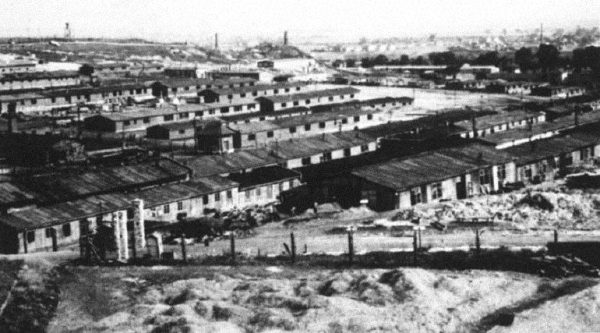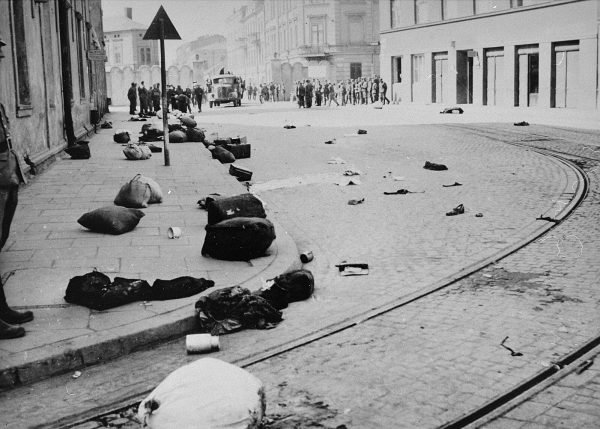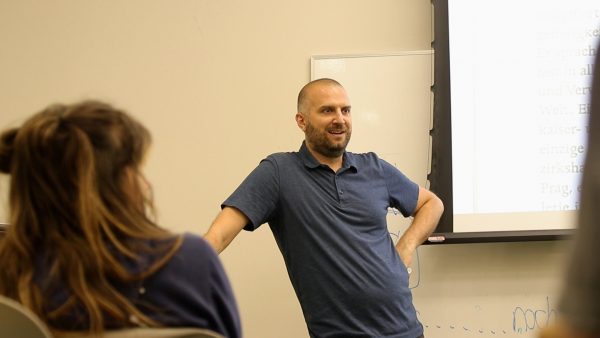
On a Sunday night in February 1997, Steven Spielberg’s Schindler’s List was broadcast on NBC, nearly uncensored and commercial-free. 65 million people tuned in, overshadowing the audience of 25 million, who three years earlier, witnessed the atrocities committed against the estimated 30,000 Jews imprisoned in the Krakow-Plazso concentration camp in their local theaters.
For many in that generation of viewers, the film became a cornerstone of their understanding and narrative of the Holocaust, witnessed in the safety of their living rooms.
“If you want to cut your teeth as an American filmmaker, as a global filmmaker, the Holocaust is often seen as one of these major challenges in the field for what is most difficult to represent and hardest to make a film about,” says Associate Professor of German and Director of International Studies, Peter Erickson.
At their inception, these cinematic and artistic depictions might serve as a

broader good in connecting history with the fading memory that comes with new generations. For the artists conveying these events, they are grappling with the question: “How do we intertwine art and atrocity?”. And yet, a more pressing question remains: “Is it right to use art to tell this story at all?”
The Questions We Should Be Asking
That question sits at the heart of Erickson’s, now award-winning curriculum on innovations, including The Holocaust in Literature and Film, a course emphasizing the ethics of making art in the wake of genocide.
“There were very prominent Holocaust survivors who believed this, that the truth was enough, that one should write histories of the Holocaust and not novels or feature fiction films,” says Erickson, “The class gives students an opportunity to engage often with very canonical works of film and literature, like, Steven Spielberg’s Schindler’s List.”
The curriculum has earned the distinction of Outstanding German Program Development and Advocacy Award from the American Council of Foreign Languages (ACFL), recognized as the most important organization of language teaching in the United States.

What’s particularly innovative about Erickson’s work, is the rethinking of “advocacy” as titled in the award itself, expanding beyond the service artistic representation might provide in Holocaust education, and advocating for a more meaningful conversation about appropriate representation, since it’s estimated there are fewer than a quarter million Jewish survivors of the Holocaust today.
“But I think the reason why a class on literature and film is so essential has to do with the question of memory,” Erickson says, “We are entering an age in which we will no longer have direct survivor testimony to draw on. And so, the question of what media representations will keep the memory of these events alive is a really crucial one.”
For Generation X and Millennials, Schindler’s List became a foundation and cultural reference point in their understanding of the Holocaust. For the Generation Z students taught by Erickson, it’s both the novel and film The Boy in the Striped Pajamas – often challenged for its historical inaccuracies, including the inaccurate perpetuation that Germans were unaware of what was happening in Concentration Camps – that sits at the core of their Holocaust imagery.
“I think one of the things that’s made the class so successful is the fact that students really have an opportunity to challenge the things that we’re reading, because the sneaking suspicion behind the class is that maybe it really isn’t legitimate to make films about the Holocaust,” Erickson says.
And his students agree. Many students as part of his surveys of the course, talk about the power of evaluating the content they have consumed on the Holocaust.
“There isn’t any right way that you have to think about a book or a movie, and it allows for a lot of discussion about the ethics of the piece and dissecting the horrors of a tragedy. And it makes you rethink a lot of values that you wouldn’t normally think about,” wrote one anonymous student in a course review.
The Importance of Holocaust Education
Regardless of initial expectations, students aren’t only challenging their own ideas surrounding artistic Holocaust representation but challenging the name itself. In fact, Erickson doesn’t hide from challenging the term “Holocaust” altogether, challenging students to think through “who has the right to name historical events?”.
“It is a decided preference among many members of the Jewish community to refer to it as the Shoah and not the Holocaust, because the term Holocaust references an idea of sacrifice,” says Erickson, “Whereas the word Shoah essentially means catastrophe.”
While the term Shoah has not resonated in the United States in the same way the term Holocaust has, what’s alarming, is the decline in understanding the toll of the Holocaust. According to a study by the Conference on Jewish Material Claims Against Germany conducted across all 50 states, 48 percent of U.S. Millennial and Gen Z participants could not name a single concentration camp used during World War II, and 36 percent thought less than 2 million Jews had been killed. Most troubling, 11 percent believe Jews caused the Holocaust.
This decline in understanding the Holocaust and its lasting impact is why Holocaust education is, by Erickson’s account, crucial to the missions of American universities.
“I think that one thing that is crucial for thinking about the German program at CSU and the German program at any American university is to really see Holocaust education as core to our mission. It is an essential part of why we have German programs in the United States, and it is our most important argument for why we matter to the mission of the American University.”
The Holocaust in Literature and Film course is one of several curriculum innovations at the helm of Erickson’s innovations he has led for the German program with the support of his colleagues. Others include Issues in Swiss and Austrian Culture and Inside Nazi Germany. For students in The Holocaust in Literature and Film, they’re given the opportunity to search through their understanding of ethics in art through deep questions, allowing them to thrive as critical thinkers in new ways.
“It challenges them very directly to ask tough questions about the ethics, and I think students really thrive when you give them tough questions when the stakes are so high.”

Peter Erickson is a tenured Associate Professor of German and the Director of the International Studies program at Colorado State University. His research focuses on the intersection of literature, art, and religion in the eighteenth, nineteenth, and twentieth centuries.